
This article is a demography of the population of Antigua and Barbuda including population density, ethnicity, religious affiliations and other aspects of the population.
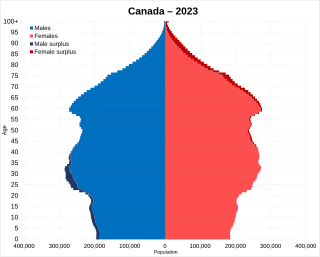
Statistics Canada conducts a country-wide census that collects demographic data every five years on the first and sixth year of each decade. The 2021 Canadian census enumerated a total population of 36,991,981, an increase of around 5.2 percent over the 2016 figure. It is estimated that Canada's population surpassed 40 million in 2023 and 41 million in 2024. Between 1990 and 2008, the population increased by 5.6 million, equivalent to 20.4 percent overall growth. The main driver of population growth is immigration, with 6.2% of the country's population being made up of temporary residents as of 2023, or about 2.5 million people. Between 2011 and May 2016, Canada's population grew by 1.7 million people, with immigrants accounting for two-thirds of the increase.
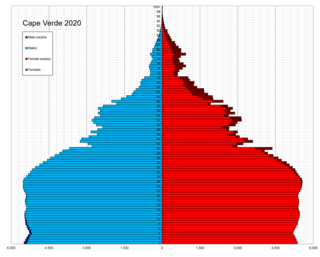
Demographic features of the population of Cape Verde include population density, ethnicity, education level, health of the populace, economic status, religious affiliations and other aspects of the population.

This is a demography of the population of the Dominican Republic including population density, ethnicity, education level, health of the populace, economic status, religious affiliations and other aspects of the population.

The population of Indonesia was 270.20 million according to the 2020 national census, an increase from 237.64 million in 2010. The official estimate as at end 2023 was 280 million increasing at a rate of 1.17% per year. Indonesia is the fourth most populous country in the world. Approximately 55% of Indonesia's population resides on Java, which is the most populous island in the world.
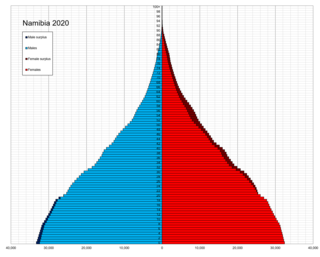
This is a demography of the population of Namibia including population density, ethnicity, education level, health of the populace, economic status, religious affiliations and other aspects of the population.
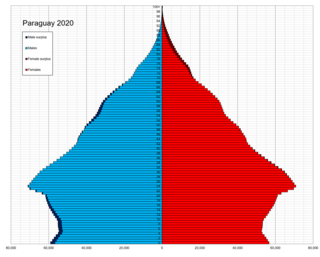
Demographic features of the population of Paraguay include population density, ethnicity, education level, health of the populace, economic status, religious affiliations and other aspects of the population.

Demographic features of the population of Rwanda include population density, ethnicity, education higher level, health of the populace, economic status, religious affiliations and other aspects.

Demographic features of the population of Seychelles include population density, ethnicity, education level, health of the populace, economic status, religious affiliations and other aspects of the population.

The demographics of Sierra Leone are made up of an indigenous population from 18 ethnic groups. The Temne in the north and the Mende in the south are the largest. About 60,000 are Krio, the descendants of freed slaves who returned to Sierra Leone from Great Britain, North America and slave ships captured on the high seas.

This is a demography of the population of The Bahamas including population density, ethnicity, education level, health of the populace, economic status, religious affiliations and other aspects of the population.

Merauke Regency is a regency in the far south of the Indonesian province of South Papua. It covers an area of 45,013.35 km2, and had a population of 195,716 at the 2010 Census and 230,932 at the 2020 Census; the official estimate as at mid 2023 was 243,722, comprising 126,508 males and 117,214 females. The administrative centre is the town of Merauke; this was projected since 2013 to become an independent city (kota) separate from Merauke Regency, but the alteration has been deferred. It is also the provincial capital of the province of South Papua, more specifically in Salor located in Kurik District. Merauke is the largest regency in Indonesia, with an area of 45,013.35 km2, slightly larger than Estonia.

Statistics Indonesia, is a non-departmental government institute of Indonesia that is responsible for conducting statistical surveys. Its main customer is the government, but statistical data is also available to the public. Annual surveys cover areas including national and provincial socio-economics, manufacturing establishments, population and the labour force.

Bone Regency is a regency of South Sulawesi province of Indonesia. Originally the seat of the Bone state, it joined Indonesia in 1950. The regency covers an area of 4,559.00 km2 and had a population of 717,682 at the 2010 census and 801,775 at the 2020 census. The official estimate of population as of mid-2023 was 820,510. Its main products are seaweed, rice, and fish. The administrative centre is the town of Watampone, which comprises the three districts of Tanete Riattang Barat, Tanete Riattang, and Tanete Riattang Timur within the regency.

The Indonesia 2010 census was conducted by Statistics Indonesia in May 2010.
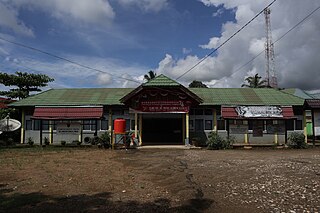
Banua Lawas is a district in Tabalong Regency, South Kalimantan Province, Indonesia. The majority of population in this district is Banjar people whose belief is Islam.
Censuses in Indonesia are censuses of Indonesia's population, agriculture, and economy conducted by Statistics Indonesia. The first census after independence was held in 1961.

The 1961 Indonesian census was the first census of Indonesia as a sovereign state. With a total population of 97,018,829, Indonesia was the world's fifth-most populous country at the time. The census covered all territories in the country, but no enumeration was done in Indonesian-claimed Western New Guinea because it was under Dutch occupation. Instead, an estimated population for the region was included in the final census numbers. During the 1961 census, its population density was 50.9 inhabitants/km2.

















